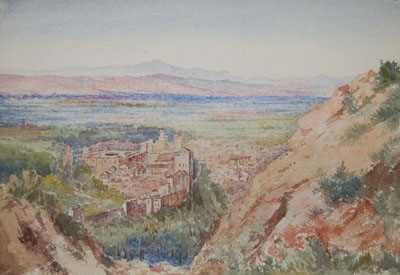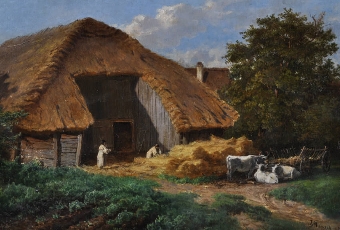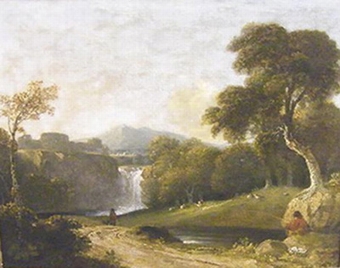the alhambra, granada spain from la silla del moro
- View other items in:
- antiques interior design modern and vintage
- other interior design
artware ltd
Enquire about this antique
Artware Ltd has 565 antiques for sale.
click here to see them all
The Alhambra ( literally "the red one"), the complete form of which was Calat Alhambra is a palace and fortress complex constructed during the mid 14th century by the Moorish rulers of the Emirate of Granada in Al-Andalus, occupying the top of the hill of the Assabica on the southeastern border of the city of Granada, now in the autonomous community of Andalusia, Spain.
The Alhambra''s Moorish palaces were built for the last Muslim Emirs (Kings) in Spain and its court, of the Nasrid dynasty. After the Reconquista by the Los Reyes Cat?licos ("The Catholic Monarchs") in 1492 some portions were used by the Christian rulers. The Palace of Charles V, built by Charles V, Holy Roman Emperor in 1527, was inserted in the Alhambra within the Nasrid fortifications. After being allowed to fall into disrepair for centuries, the Alhambra was "discovered" in the 19th century by European scholars and travelers, with restorations commencing. It is now one of Spain''s major tourist attractions, exhibiting the country''s most significant and well known Islamic architecture, together with 16th-century and later Christian building and garden interventions. The Alhambra is a UNESCO World Heritage Site.
Completed towards the end of Muslim rule of Spain by Yusuf I (1333?1353) and Muhammed V, Sultan of Granada (1353?1391), the Alhambra is a reflection of the culture of the last centuries of the Moorish rule of Al Andalus, reduced to the Nasrid Emirate of Granada. It is a place where artists and intellectuals had taken refuge as the Reconquista by Spanish Christians won victories over Al Andalus. The Alhambra integrates natural site qualities with constructed structures and gardens, and is a testament to Moorish culture in Spain and the skills of Muslim, Jewish, and Christian artisans, craftsmen, and builders of their era. The first reference to the Qal?at al Hambra was during the battles between the Arabs and the Muladies during the rule of the ?Abdullah ibn Muhammad (r. 888-912). In one particularly fierce and bloody skirmish, the Muladies soundly defeated the Arabs, who were then forced to take shelter in a primitive red castle located in the province of Elvira, presently located in Granada. According to surviving documents from the era, the red castle was quite small, and its walls were not capable of deterring an army intent on conquering. The castle was then largely ignored until the eleventh century, when its ruins were renovated and rebuilt by Samuel ibn Naghrela, vizier to the King Badis of the Zirid Dynasty of Al Andalus, in an attempt to preserve the small Jewish settlement also located on the Sabikah hill. However, evidence from Arab texts indicates that the fortress was easily penetrated and that the actual Alhambra that survives today was built during the Nasrid Dynasty. Emblem of the Catholic Monarchs engraved after the conquest.Ibn Nasr, the founder of the Nasrid Dynasty, was forced to flee to Ja?n in order to avoid persecution by King Ferdinand III of Castile and the Reconquista supporters working to end Spain''s Moorish rule. After retreating to Granada, Ibn-Nasr took up residence at the Palace of Badis in the Alhambra. A few months later, he embarked on the construction of a new Alhambra fit for the residence of a king. According to an Arab manuscript since published as the An?nimo de Granada y Copenhague.
This year, 1238 Abdallah ibn al-Ahmar climbed to the place called "the Alhambra" inspected it, laid out the foundations of a castle and left someone in charge of its construction?The design included plans for six palaces, five of which were grouped in the northeast quadrant forming a royal quarter, two circuit towers, and numerous bathhouses. During the reign of the Nasrid Dynasty, the Alhambra was transformed into a palatine city complete with an irrigation system composed of acequias for the gardens of the Generalife located outside the fortress. Previously, the old Alhambra structure had been dependent upon rainwater collected from a cistern and from what could be brought up from the Albaic?n. The creation of the Sultan''s Canal solidified the identity of the Alhambra as a palace-city rather than a defensive and ascetic structure.
The Muslim ruler Muhammad XII of Granada surrendered the Emirate of Granada in 1492 without the Alhambra itself being attacked when the forces of Los Reyes Cat?licos, King Ferdinand II of Aragon and Queen Isabella I of Castile, took the surrounding territory with an overwhelming force of numbers.
Antiques.co.uk Ref: H5EM9JW6
- Materials:
- Pencil and Watercolour
- Width (cm):
- 19.50 x 28.50 cm 7.68 x 11.22 ins
Artware Ltd
Artware Fine Art specialises in fine antique, decorative and historical portraits and topographical pictures . We cover a period from the 17th and 18th centuries through to the 19th & 20th Centuries. We have over 150 portraits in stock, which can be viewed on our web site, each historical portrait has well researched biographical information both on the sitter and the artist.
Contact details
18 La gare
51 Surrey row
London
Greater London
SE1 0BZ
UNITED KINGDOM
T: 0207 921 97904
E: greg@artwarefineart.com
W: www.artwarefineart.com














